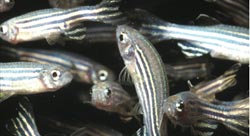Mechanisms of Wound Healing are Clarified in Zebrafish Study

Zebrafish (Danio rerio). Credit: Lukas Roth<br>
How do these neighboring skin cells know which way to migrate? What directional cues are they receiving from the wound site? A new paper by Mark Messerli and David Graham of the MBL’s Eugene Bell Center for Regenerative Biology and Tissue Engineering clarifies the role of calcium signaling in this medically significant communication between skin cells.
Messerli and Graham conducted the study using zebrafish skin cells, which migrate much faster than human cells. “Fish have to heal quickly,” Messerli says. “They are surrounded by microbes and fungi in the water. They are constantly losing scales, which generates a wound. So the wound has to be healed in the epidermis first and then a new scale has to be built. Fish skin cells (keratinocytes) migrate five times faster at room temperature than mammalian cells do at 37 degrees C. So it is very easy to track and follow their migratory paths in a short period of time. “
The study brought fresh insights on the role of calcium signaling in inducing cellular organization and directed migration of skin cells. “When we started this study, we were looking at calcium signaling at the single-cell level, which is how it has been looked at for decades. How do single cells see injury?” Messerli says.
To their surprise, by the end of the study they were looking at the calcium signals not just in single cells but in sheets of cells that surround wounds. “The periphery of the wound itself appears to form a graded calcium signal that could direct migration and growth toward the center of the wound. This is what we are looking at now,” Messerli says.
The Team’s approach was to use advanced microscopy to monitor cellular calcium signals and molecular analysis to identify membrane proteins that caused increases in cellular calcium migration. A variety of mechanically activated ion channels were identified in migratory skin cells. TRPV1, the ion channel that is also activated by hot peppers, was found to be necessary for migration.
Messerli’s co-authors on the paper include David Graham, formerly a research assistant at MBL and now a graduate student at University of North Carolina Chapel Hill School of Medicine, and colleagues at Purdue University. Messerli also holds an appointment in the MBL’s Cellular Dynamics Program.
Citation:
Graham DM, Huang L, Robinson KR, and Messerli MA (2013) Epidermal keratinocyte polarity and motility require Ca2+ influx through TRPV1. J Cell Sci. 126: 4602-4613.
The Marine Biological Laboratory (MBL) is dedicated to scientific discovery and improving the human condition through research and education in biology, biomedicine, and environmental science. Founded in Woods Hole, Massachusetts, in 1888, the MBL is a private, nonprofit institution and an affiliate of the University of Chicago.
Media Contact
More Information:
http://www.mbl.eduAll latest news from the category: Life Sciences and Chemistry
Articles and reports from the Life Sciences and chemistry area deal with applied and basic research into modern biology, chemistry and human medicine.
Valuable information can be found on a range of life sciences fields including bacteriology, biochemistry, bionics, bioinformatics, biophysics, biotechnology, genetics, geobotany, human biology, marine biology, microbiology, molecular biology, cellular biology, zoology, bioinorganic chemistry, microchemistry and environmental chemistry.
Newest articles

After 25 years, researchers uncover genetic cause of rare neurological disease
Some families call it a trial of faith. Others just call it a curse. The progressive neurological disease known as spinocerebellar ataxia 4 (SCA4) is a rare condition, but its…

Lower dose of mpox vaccine is safe
… and generates six-week antibody response equivalent to standard regimen. Study highlights need for defined markers of mpox immunity to inform public health use. A dose-sparing intradermal mpox vaccination regimen…

Efficient, sustainable and cost-effective hybrid energy storage system for modern power grids
EU project HyFlow: Over three years of research, the consortium of the EU project HyFlow has successfully developed a highly efficient, sustainable, and cost-effective hybrid energy storage system (HESS) that…





















